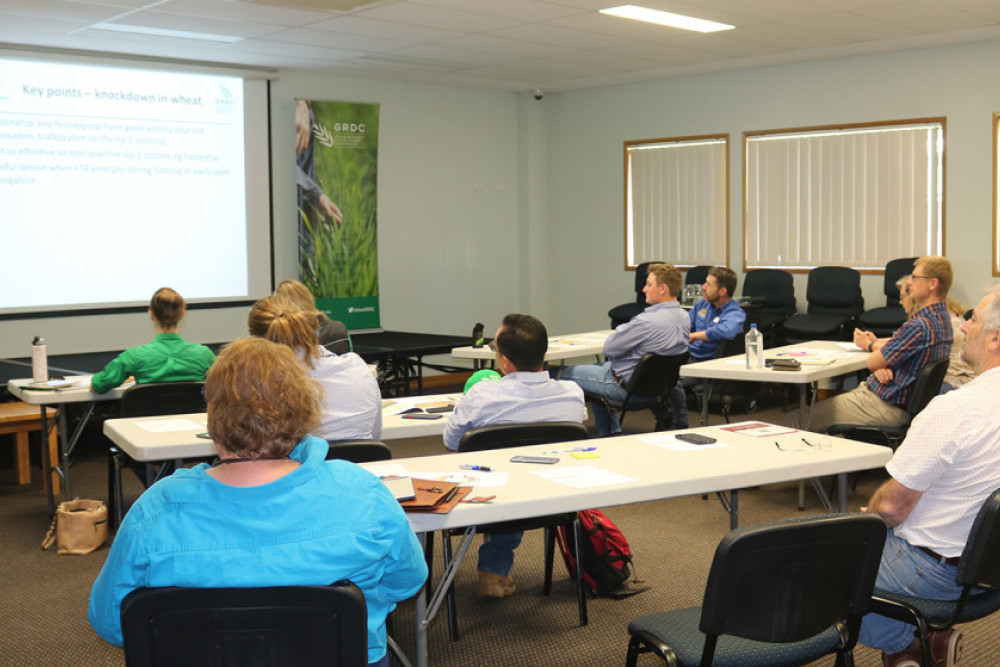Agricultural
6 April, 2022
National Grower Network Forum held in Pittsworth
The Grains Research and Development Corporation (GRDC) came to Pittsworth at the end of March to host a National Grower Network Grower Forum, which presented an opportunity for GRDC to connect directly with those working in the paddock so their insights and experience can help inform future research, development and extension investments.

Graingrowers, advisers, researchers and industry partners were invited to discuss the opportunities and constraints impacting grain production in southern Queensland with GRDC.
The forum presented locals with a chance to hear from specialist researchers on regionally relevant topics.
GRDC’s Grower Relations Manager North, Richard Holzknect said a similar event was hosted in three locations to hear from locals in different areas.
“This week we’re heading to three events, one based in Pittsworth and another one out at Bellata in Northern NSW and then back up into Queensland to Meandarra,” Mr Holzknect said.
“At each one of those events what we’re doing is bringing researchers out to those areas that do our trial work and we’re providing an opportunity for growers to come along and ask questions about the project they’ve been working on.
“Today in Pittsworth we were talking around summer grass control, so we heard from Michael Widderick from DAF Queensland who is a weed research scientist working on weed resistance surveys.
“He is also primarily involved in looking at crop competition, so how wheat and barley planted at different row spacings or how populations can impact on weed production or the development of seeds from the weeds.
“We were then also joined by Northern Grower Alliance CEO Richard Daniel.
“Richard works on a GRDC project relating to how to use agronomic tools to manage key weeds.
“He was looking at the controller for Feathertop Rhodes grass using a range of herbicides that are currently labelled available and how that works in relation to soil moisture, environment, germination opportunities proceeding sorghum, and also what the use of pre-emergent herbicides then have on the benefit of Feathertop Rhodes grass in crop.
“So, it’s using a lot of high level science that DAF Queensland did with some of the agronomic practices that NGA (Northern Grower Alliance) were trialling.”
Mr Holzknect said as well as hearing from those who are working on GRDC projects, the purpose of the event was to share the findings thus far and hear from locals.
“We also use this as an opportunity for those in the room to understand opportunities and constraints that are impacting on production,” he said.
“We’re using this to better guide where our research money is being spent so we’re actually targeting the constraints that growers or industry identify as a need.
“This really informs how we, as GRDC, invest on behalf of our growers.”
Mr Holzknect said the idea is that hearing from locals on the ground helps to tailor localised research that will help to combat issues they are facing.
“GRDC invests in over 750 research projects in a year,” he said.
“We often find that we’re actually already doing work on some of the issues that are raised, so this is an opportunity for us to feed back information on what we’re already doing, but also better understanding the context to see if that issue is being addressed in the right way or if we need to address another little aspect of that to improve the way its being addressed, so it’s a constant improvement sort of style.”
Mr Holzknect said that throughout the forum they also discussed alternate desiccation opportunities and looked at nutrient removal and how it can be balanced out with better fertilising practices.
They also spoke about general weed management and companion cropping.
“We know that a lot of growers are looking at alternate cropping systems, so we had a good discussion around companion cropping, and that’s growing one or two crops in the same unit of area across time and space,” Mr Holzknect said.
“So, we could look at cover cropping as an example of that, where we plant a crop and we then harvest through a fallow, but during that fallow period if we don’t have enough cover then we can lose too much moisture, and a lot of our farming is based on that moisture component.
“If we can grow a cover crop during that period to provide better coverage, then when it does rain and we take that cover crop out at a point of time we can then use that cover to store water more effectively before we go back in and rotational plant.
“It’s how do we actually combine plants across time and space to improve productivity.”
Mr Holzknect said a range of people attended the event to hear from experts, to participate in discussions and have their say.
“We’ve got a range of growers, farmers, industry experts and researchers that came along and they’ve all got touch points with growers about what they see are impacting them,” he said.
“It’s always interesting because you do get a diversity of views in the room,” he said.
“We had good engagement and good discussion, but we always encourage more growers to come along.
“This time we had 12 growers and advisers in the room.”
Mr Holzknect said despite lower numbers than usual due the event being rescheduled from February when it couldn’t go ahead due to COVID, overall the forum in Pittsworth went well.
The next GRDC research update is set to go ahead in early August and those interested are encouraged to stay tuned for more information.


